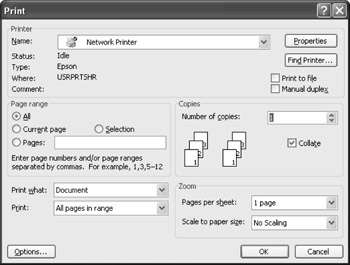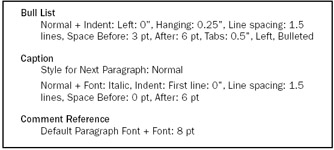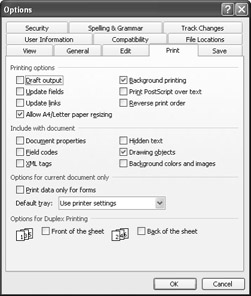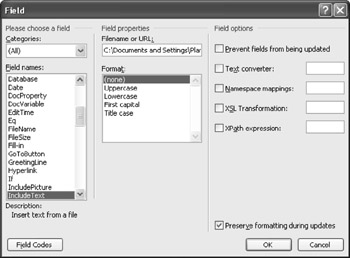Controlling Print Jobs
|
| < Day Day Up > |
|
As an experienced user, you probably need to perform printing tasks that are more complex than merely printing single copies of entire documents. Thus, instead of clicking the Print button on the Standard toolbar, you'll probably benefit more by pressing Ctrl+P or choosing File, Print so that you can take advantage of the options available in the Print dialog box, shown in Figure 3-4. In this part of the chapter, you'll learn how to customize and control many of Word's printing settings.

Figure 3-4: The Print dialog box provides many of the options that you can use to control your print jobs.
Printing More Than One Copy of a Single Document
To print multiple copies of a document, display the Print dialog box, and then select or type a value in the Number Of Copies box. By default, Word collates multiple copies of a print job. (Notice that the Collate check box is selected in the Copies section in the Print dialog box.) When collating is enabled, Word sends one copy of your print job to the printer, waits a moment, sends the next copy to the printer, and so on. The result is that the entire selection or document is printed, then the next copy is printed, and so forth. In the long run, this method is probably easier for an end user, but it takes longer to process and can cause bottlenecks in a print queue if the document contains many large graphics or extensive formatting. If you prefer, you can clear the Collate check box. Word will then send the printer all copies of the first page, all copies of the second page, and so forth, leaving you to collate the copies manually. On some laser printers, printing without collating might speed the process and avoid bottlenecks in the print queue because the printer won't have to reprocess information for each copy of a page.
Printing Ranges
In many cases, you'll want to print a selection of pages instead of an entire document. For example, you might want to select and print a few paragraphs of text instead of an entire Web page; you might want to print two or three noncontiguous sections within a long report; or you might want to print the cover letter attached to your updated résumé. To print specific pages and sections within a document, use the following options in the Page Range section of the Print dialog box:
-
All Prints the entire document; the default selection. To print an entire document, display the Print dialog box, and then click OK.
-
Current Page Prints the page in which your insertion point is currently located. To use this option, click in the page you want to print, display the Print dialog box, click Current Page, and then click OK.
-
Selection Prints selected text. To use this option, select the content you want to print, display the Print dialog box, click Selection, and then click OK.
Cross-Reference To review text selection methods, see Chapter 2, "Mastering Document Fundamentals."
-
Pages Prints only the pages, page ranges, and sections you specify. You can use commas and hyphens with the letters s (for section) and p (for page<//emphasis>) to specify which pages, sections, and page ranges you want to print. For example, enter 1-5,9,15-18 to print pages 1 through 5, page 9, and pages 15 through 18; enter s2,s4 to print sections 2 and 4; and enter p3s4-p6s5 to print from page 3, section 4, to page 6, section 5.
Cross-Reference For more information about defining and using sections, see Chapter 15, "Mastering Page Setup and Pagination," and Chapter 19, "Formatting Columns and Sections for Advanced Text Control."
If you want to print using both sides of each sheet of paper but you don't have a duplex printer (a printer that can automatically print on both sides of a sheet), you can use the Odd Pages and Even Pages print options in Word to work around the limitation. To accomplish this, you can print all the odd pages first, turn the printed pages over, reinsert the paper into your printer's paper tray, and then print the even pages. You'll probably have to experiment with your printer tray to ensure that you insert the paper properly. (Usually, the odd pages would go in face down with the top of the page positioned to feed into the printer first.) Bear in mind that printing this way too often can cause printers to jam eventually as a result of the ink from the already printed pages building up as they pass through your printer. If you do a lot of two-sided printing, you should probably invest in a printer that is designed to handle it.
To configure a print job to print only odd or even pages, display the Print dialog box and select either Odd Pages or Even Pages in the Print drop-down list. By default, the All Pages In Range option is selected.
You can use the Odd Pages and Even Pages options in combination with specified page ranges. For example, you can print only the odd pages in the range from page i110 through page 213 by specifying 110-213 in the Pages box and selecting Odd Pages in the Print list.
Printing Document Elements
As you know, documents consist of much more than just the content that appears on a page. Documents can include property settings, editing marks, comments, keyboard shortcut assignments, formatting styles, and so forth. In some cases, you might want to print a document's informational elements instead of the actual document. The Print dialog box enables you to print some common document elements by selecting them in the Print What list. Using this technique, you can print the following elements:
-
Document Prints the entire document; the default setting.
-
Document Properties Prints basic information about a file, such as the file name, directory, template, title, author, creation date, last saved date, number of words, and so forth. This information is similar to the information stored in the file's Properties dialog box. You can view a file's properties without printing the information by opening a document and choosing File, Properties.
-
Document Showing Markup Prints the document and all the tracked changes made in the text. In addition, each comment inserted into the document is printed in the margin of the corresponding page in a box called a bubble box, with dashed lines indicating the insertion point of each comment. You can see how a marked-up document will be printed by previewing the document in Print Preview mode, as shown in Figure 3-5. Keep in mind that if you have turned on tracking so that all revisions appear in your document when you send that document to print, the Document Showing Markup print option is selected in the Print dialog box by default.

Figure 3-5: A document printed with markup shows all tracked changes and comments along with the document's contents, similar to how a marked-up document appears in Print Preview mode.Cross-Reference For information about using markup features, see Chapter 27, "Revising Documents Using Markup Tools."
-
List Of Markup Prints each tracked change made in a document on a separate line below a color-coded heading. The color-coding is based on who made each change, and each heading's text indicates page number, action (deleted, inserted, or comment), name of the user who made the change, and the date and time of the modification. This printout provides a very detailed list of changes. If the document contains more than a few changes or comments, this print job could take a few minutes to queue and even longer to print. Keep in mind that this option can create fairly large print files, so use this option with discretion.
Tip Print additional document information You can print other document components in addition to those in the Print What list, as we describe throughout this book. For example, to print hidden text and field codes, display them in your document before you print (as described in "Setting Printing Options," later in this chapter); to print an outline of your document, display the document in Outline view before you print; and to print a Web page's HTML source code, choose View, HTML Source before printing.
-
Styles Creates an alphabetical list of styles used in the current document. Each list entry includes the style's parameters, in reveal formatting style. For example, an excerpt from a Styles printout might look like this:

Cross-Reference For more information about creating and using styles, see Chapter 9, "Using Styles to Increase Your Formatting Power."
-
AutoText Entries Prints a complete alphabetical list of the AutoText entries associated with the template attached to the current document. By default, the Normal.dot template is attached to documents if no other template has been specified.
Cross-Reference For more information about AutoText, see Chapter 7, "Putting Text Tools to Work."
-
Key Assignments Prints an alphabetical list of custom shortcut keys created for standard Word commands or macros.
Cross-Reference For more information about working with macros, see Chapter 32, "Creating and Working with VBA Macros."
Troubleshooting: Printing a markup list for a page range doesn't work
Unfortunately, you can't print a markup list for a range of pages—you have to print either a complete list of all the changes made to an entire document or none at all. Luckily, if you're flexible, you can work around this limitation. The easiest approach is to forget about the list and instead print a range of pages using the Document Showing Markup option. You'll be able to see the tracked changes and comments in this view—it just won't be printed in list format (and in many cases, the changes make more sense when you see them in a document instead of listed one after another). Of course, in some instances, you might really need to print a list of markups for a range of pages. Don't worry—there's still hope. One way you can accomplish this is to follow these easy steps:
-
Make sure the marked-up document is open in Word with the changes visible.
-
Select the range you want to use to generate a markup list, and copy it to the Clipboard (press Ctrl+C or click Copy on the Standard toolbar).
-
Click the New Blank Document button.
-
Paste the copied selection into the new blank document.
-
Display the Print dialog box (press Ctrl+P or choose File, Print), select List Of Markup in the Print What drop-down list, and then click OK.
-
After the list is printed, close the new blank document without saving it.
Printing Draft Copies
In some instances, you might want to quickly print a document's text without "extras" like formatting and graphics. In these cases, you can print a draft copy, if your printer supports this option. You can activate the draft printing feature using one of these techniques:
-
Choose Tools, Options, click the Print tab (shown in Figure 3-6), select the Draft Output check box in the Printing Options section, and then click OK.

Figure 3-6: Print options are available in the Print tab in the Options dialog box, as shown here, or by clicking the Options button in the Print dialog box. -
Display the Print dialog box, click the Options button, select the Draft Output check box, and then click OK.
When you print a document using Draft mode, your printed document will contain minimal formatting and no graphics.
Printing Several Pages Per Sheet
In Word, you can print more than one document page on a single sheet of paper. This feature, introduced in Word 2000, helps you to better see a document's layout and can be used to present information in a visually concise manner. You'll find that printing several pages per sheet is similar to previewing multiple pages in Print Preview mode. (The difference is that the printed pages generally provide a clearer view of the pages' contents.) When you print multiple pages on a single sheet of paper, Word shrinks the pages to the appropriate size for printing purposes. To set up this arrangement, follow these steps:
-
Press Ctrl+P or choose File, Print.
-
In the Zoom section of the Print dialog box, select the number of pages per sheet you want to print in the Pages Per Sheet drop-down list. You can print up to 16 pages per sheet.
Note The Pages Per Sheet feature has a few limitations. First, you must use the values in the Pages Per Sheet drop-down list to specify the number of pages to be printed—you can't type a value. In addition, the feature is available only when the Document or Document Showing Markup option is selected in the Print What list.
Scaling Printed Documents
Just as you can reduce and enlarge copies when you use a photocopier, you can reduce and enlarge your print output in Word by using the Scale To Paper Size feature. Scaling documents can come in handy when you are printing on nonstandard paper sizes or when you want to shrink your output slightly to ensure that information isn't cut off by margin settings.
The key to scaling documents is to use the Scale To Paper Size list, which is located in the Zoom section in the Print dialog box. The Scale To Paper Size list includes a variety of sizing options, including Letter, Legal, A4, various envelope sizes, and so forth. To view the list of options, click the Scale To Paper Size list. By default, the No Scaling option is selected.
| Note | Scaling a document using the Print dialog box scales your document for the current printing session only; it doesn't resize or alter the document's contents, unlike the Shrink To Fit feature in Print Preview mode, which modifies the formatting in your document. |
Printing XML Tags
New Feature When you work with an XML document, you can configure Word to include the XML tags in the printed document whether or not you're working with the XML tags visible onscreen. Printing an XML document—XML tags and all—is a simple matter of selecting the XML Tags check box before you print, in either of the following ways:
-
Choose Tools, Options, click the Print tab (shown previously in Figure 3-6), select the XML Tags check box, and then click OK.
-
Display the Print dialog box, click Options, select the XML Tags check box, and then click OK.
After you select the XML Tags check box, the tags will appear, embedded in the document, when you print. To hide the XML tags in a printed document, ensure that the XML Tags check box in the print options is cleared.
Printing Background Colors and Images
New Feature If your document uses background colors or images (such as a watermark), you can specify whether to print the colors or images when you print the document. To control background color and image printing, perform either of the following actions:
-
Choose Tools, Options, click the Print tab (shown previously in Figure 3-6), select the Background Colors And Images check box, and then click OK.
-
Display the Print dialog box, click Options, select the Background Colors And Images check box, and then click OK.
To revert to the default setting of not printing background colors and images, make sure the Background Colors And Images check box in the print options is cleared.
Using INCLUDETEXT to Print Information from Multiple Documents
You can use the INCLUDETEXT field to insert (and subsequently print) text and graphics from named documents into the current document. To accomplish this, simply insert the INCLUDETEXT field where you want to insert the contents of another document (for example, at the end of the active document), and then print.
To include the contents of an entire document within the current document when you print, follow these steps:
-
Position the insertion point where you want the included text to display and print.
-
Click Insert, Field.
-
In the Field dialog box, select IncludeText in the Field Names list, and specify the included document's path in the File Name Or URL text box, as shown in Figure 3-7.

Figure 3-7: You can use the INCLUDETEXT field to help manage and print long documents and multipart publications. -
Click OK.
You can control how field codes appear in your document by selecting the Field Codes check box and setting the Field Shading list in the View tab in the Options dialog box (by choosing Tools, Options, and then display the View tab). After you add the INCLUDETEXT field, the content of the included documents will print when you print the active document.
| Cross-Reference | For more information about using fields, see Chapter 31, "Working with Field Codes and Custom Forms." |
Printing Data from a Form
In Word, you can print only the data entered in a form by selecting the settings in the Print tab, as described here:
-
Open the document containing the data you want to print.
-
Choose Tools, Options, and then click the Print tab.
-
In the Options For Current Document Only section, select the Print Data Only For Forms check box, and then click OK.
-
Click the Print button on the Standard toolbar.
Creating a Print File
At times, you might want to create a print file instead of sending your document to your local printer. Usually, print files are created when a file needs to be printed on another printer (generally one of higher quality). For example, if you create a work document in your home office, you might want to create a print file so that you can print the document on your company's high-quality color printer. Alternatively, perhaps you have developed a magazine or newsletter on your computer at work, but you want to submit a print file to a print shop so that they can create the final version.
Essentially, when you create a print file, you save your document in a format that another printer can recognize. When you print to a file, Word preserves the document's layout information, such as font spacing, line breaks, and page breaks.
To create a print file, follow these steps:
-
Determine which printer (for example, a PostScript printer) will be used, and install a printer driver for that printer, if necessary. (Ask your print shop or network administrator for a copy of the appropriate printer driver if you need one, or download it from the Web.)
-
Display the Print dialog box (by choosing File, Print, or pressing Ctrl+P).
-
In the Name list, select the printer that will print the file.
-
Select the Print To File check box, and then click OK to display the Print To File dialog box, which looks similar to the Save As dialog box.
-
Navigate to the location in which you want to save the print file, type a name for the print file in the File Name box, and then click OK. Word saves the file with a .prn extension.
|
| < Day Day Up > |
|
EAN: 2147483647
Pages: 373